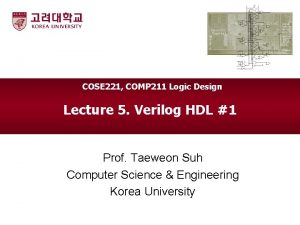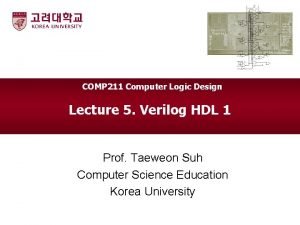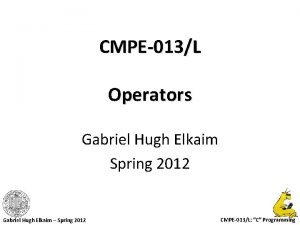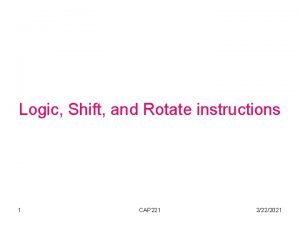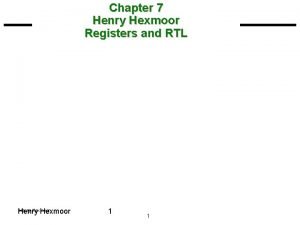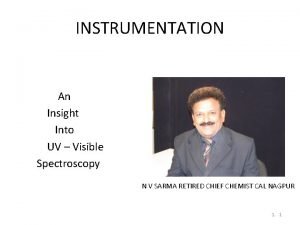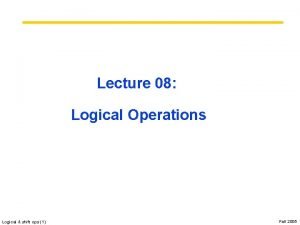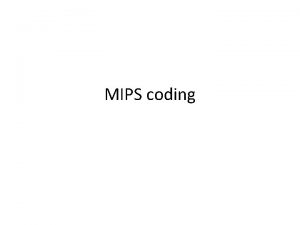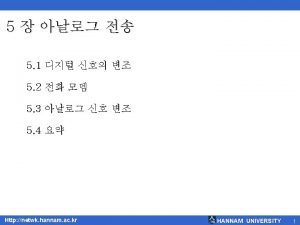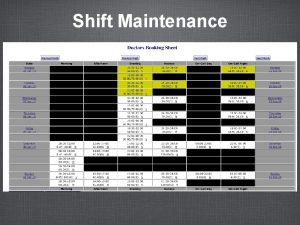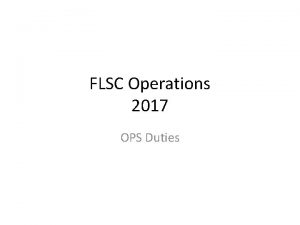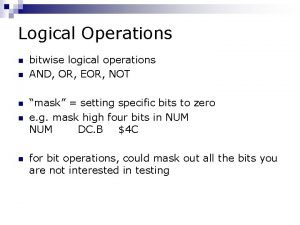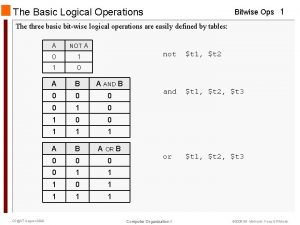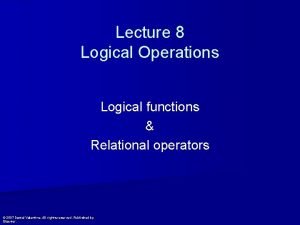Lecture 08 Logical Operations Logical shift ops 1













- Slides: 13

Lecture 08: Logical Operations Logical & shift ops (1) Fall 2005

Bitwise Operations • Up until now, we’ve done arithmetic (add, sub, addi ), memory access (lw and sw), and branches and jumps. • All of these instructions view contents of register as a single quantity (such as a signed or unsigned integer) • New Perspective: View register as 32 raw bits rather than as a single 32 -bit number • Since registers are composed of 32 bits, we may want to access individual bits (or groups of bits) rather than the whole. • Introduce two new classes of instructions: • Logical & Shift Ops Logical & shift ops (2) Fall 2005

Logical Operators (1/3) • Two basic logical operators: • AND: outputs 1 only if both inputs are 1 • OR: outputs 1 if at least one input is 1 • Truth Table: Logical & shift ops (3) A B 0 0 A AND B 0 0 1 1 1 0 0 1 A OR B 0 1 1 1 Fall 2005

Logical Operators (2/3) • Logical Instruction Syntax: 1 2, 3, 4 • where 1) operation name 2) register that will receive value 3) first operand (register) 4) second operand (register) or immediate (numerical constant) • In general, can define them to accept > 2 inputs, but in the case of MIPS assembly, these accept exactly 2 inputs and produce 1 output • Again, rigid syntax, simpler hardware Logical & shift ops (4) Fall 2005

Logical Operators (3/3) • Instruction Names: • and, or: Both of these expect the third argument to be a register • andi, ori: Both of these expect the third argument to be an immediate • MIPS Logical Operators are all bitwise, meaning that bit 0 of the output is produced by the respective bit 0’s of the inputs, bit 1 by the bit 1’s, etc. • C: Bitwise AND is & (e. g. , z = x & y; ) • C: Bitwise OR is | (e. g. , z = x | y; ) Logical & shift ops (5) Fall 2005

Uses for Logical Operators (1/3) • Note that anding a bit with 0 produces a 0 at the output while anding a bit with 1 produces the original bit. • This can be used to create a mask. • Example: 1011 0110 1010 0100 0011 1101 1010 mask: 0000 0000 1111 • The result of anding these: 0000 0000 1101 1010 mask last 12 bits Logical & shift ops (6) Fall 2005

Uses for Logical Operators (2/3) • The second bitstring in the example is called a mask. It is used to isolate the rightmost 12 bits of the first bitstring by masking out the rest of the string (e. g. setting it to all 0 s). • Thus, the and operator can be used to set certain portions of a bitstring to 0 s, while leaving the rest alone. • In particular, if the first bitstring in the above example were in $t 0, then the following instruction would mask it: andi $t 0, 0 x. FFF Logical & shift ops (7) Fall 2005

Uses for Logical Operators (3/3) • Similarly, note that oring a bit with 1 produces a 1 at the output while oring a bit with 0 produces the original bit. • This can be used to force certain bits of a string to 1 s. • For example, if $t 0 contains 0 x 12345678, then after this instruction: ori $t 0, 0 x. FFFF • … $t 0 contains 0 x 1234 FFFF (e. g. the high-order 16 bits are untouched, while the low-order 16 bits are forced to 1 s). Logical & shift ops (8) Fall 2005

Shift Instructions (1/4) • Move (shift) all the bits in a word to the left or right by a number of bits. • Example: shift right by 8 bits 0001 0010 0011 0100 0101 0110 0111 1000 0000 0001 0010 0011 0100 0101 0110 • Example: shift left by 8 bits 0001 0010 0011 0100 0101 0110 0111 1000 0000 Logical & shift ops (9) Fall 2005

Shift Instructions (2/4) • Shift Instruction Syntax: 1 2, 3, 4 • where 1) operation name 2) register that will receive value 3) first operand (register) 4) shift amount (constant < 32) • MIPS shift instructions: 1. sll (shift left logical): shifts left and fills emptied bits with 0 s 2. srl (shift right logical): shifts right and fills emptied bits with 0 s 3. sra (shift right arithmetic): shifts right and fills emptied bits by sign extending Logical & shift ops (10) Fall 2005

Shift Instructions (3/4) • Example: shift right arith by 8 bits 0001 0010 0011 0100 0101 0110 0111 1000 0000 0001 0010 0011 0100 0101 0110 • Example: shift right arith by 8 bits 1001 0010 0011 0100 0101 0110 0111 1000 1111 1001 0010 0011 0100 0101 0110 Logical & shift ops (11) Fall 2005

Shift Instructions (4/4) • Since shifting may be faster than multiplication, a good compiler usually notices when C code multiplies by a power of 2 and compiles it to a shift instruction: a *= 8; (in C) would compile to: sll $s 0, 3 (in MIPS) • Likewise, shift right to divide by powers of 2 • remember to use sra Logical & shift ops (12) Fall 2005

“And in Conclusion…” • Logical and Shift Instructions • Operate on bits individually, unlike arithmetic, which operate on entire word. • Use to isolate fields, either by masking or by shifting back and forth. • Use shift left logical, sll, for multiplication by powers of 2 • Use shift right arithmetic, sra, for division by powers of 2. • New Instructions: and, andi, ori, sll, sra Logical & shift ops (17) Fall 2005
 Difference between arithmetic shift and logical shift
Difference between arithmetic shift and logical shift Difference between arithmetic shift and logical shift
Difference between arithmetic shift and logical shift Gabriel hugh elkaim
Gabriel hugh elkaim Cap 221
Cap 221 Difference between arithmetic shift and logical shift
Difference between arithmetic shift and logical shift Posselt's diagram
Posselt's diagram Homocyclic diene component
Homocyclic diene component Aniline uv spectrum
Aniline uv spectrum Bathochromic shift and hypsochromic shift
Bathochromic shift and hypsochromic shift 01:640:244 lecture notes - lecture 15: plat, idah, farad
01:640:244 lecture notes - lecture 15: plat, idah, farad Logical operators
Logical operators What is sll in mips
What is sll in mips Om306
Om306 Exclusive or logical equivalence
Exclusive or logical equivalence
